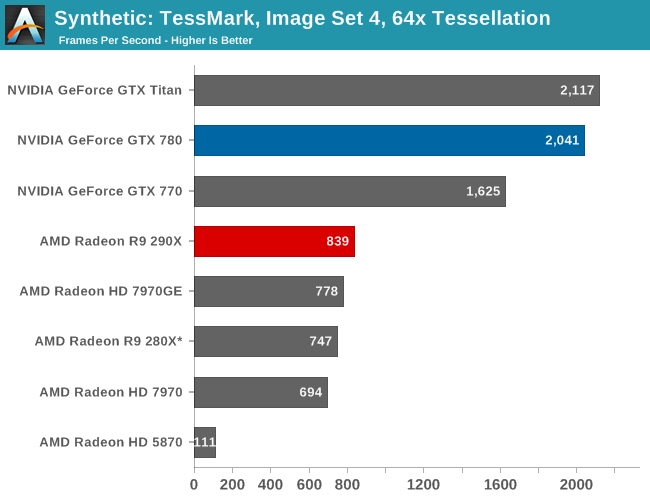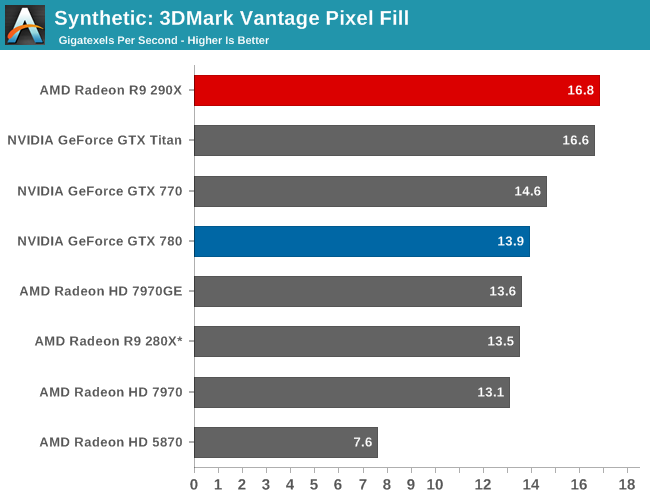The AMD Radeon R9 290X Review
by Ryan Smith on October 24, 2013 12:01 AM EST- Posted in
- GPUs
- AMD
- Radeon
- Hawaii
- Radeon 200
Synthetics
As always we’ll also take a quick look at synthetic performance. The 290X shouldn’t pack any great surprises here since it’s still GCN, and as such bound to the same general rules for efficiency, but we do have the additional geometry processors and additional ROPs to occupy our attention.

Right off the bat then, the TessMark results are something of a head scratcher. Whereas NVIDIA’s performance here has consistently scaled well with the number of SMXes, AMD’s seeing minimal scaling from those additional geometry processors on Hawaii/290X. Clearly Tessmark is striking another bottleneck on 290X beyond simple geometry throughput, though it’s not absolutely clear what that bottleneck is.
This is a tessellation-heavy benchmark as opposed to a simple massive geometry bencehmark, so we may be seeing a tessellation bottleneck rather than a geometry bottleneck, as tessellation requires its own set of heavy lifting to generate the necessary control points. The 12% performance gain is much closer to the 11% memory bandwidth gain than anything else, so it may be that the 280X and 290X are having to go off-chip to store tessellation data (we are after all using a rather extreme factor), in which case it’s a memory bandwidth bottleneck. Real world geometry performance will undoubtedly be better than this – thankfully for AMD this is the pathological tessellation case – but it does serve of a reminder of how much more tessellation performance NVIDIA is able to wring out of Kepler. Though the nearly 8x increase in tessellation performance since 5870 shows that AMD has at least gone a long way in 4 years, and considering the performance in our tessellation enabled games AMD doesn’t seem to be hurting for tessellation performance in the real world right now.
Moving on, we have our 3DMark Vantage texture and pixel fillrate tests, which present our cards with massive amounts of texturing and color blending work. These aren’t results we suggest comparing across different vendors, but they’re good for tracking improvements and changes within a single product family.

Looking first at texturing performance, we can see that texturing performance is essentially scaling 1:1 with what the theoretical numbers say it should. 36% better texturing performance over 280X is exactly in line with the increased number of texture units versus 280X, at the very least proving that 290X isn’t having any trouble feeding the increased number of texture units in this scenario.

Meanwhile for our pixel fill rates the results are a bit more in the middle, reflecting the fact that this test is a mix of ROP bottlenecking and memory bandwidth bottlenecking. Remember, AMD doubled the ROPs versus 280X, but only gave it 11% more memory bandwidth. As a result the ROPs’ ability to perform is going to depend in part on how well color compression works and what can be recycled in the L2 cache, as anything else means a trip to the VRAM and running into those lesser memory bandwidth gains. Though the 290X does get something of a secondary benefit here, which is that unlike the 280X it doesn’t have to go through a memory crossbar and any inefficiencies/overhead it may add, since the number of ROPs and memory controllers is perfectly aligned on Hawaii.










396 Comments
View All Comments
Ryan Smith - Friday, October 25, 2013 - link
Patch 3, which was the patch released right before the 280X, settled the major GPU problems. I can't speak for the turn sequences, which are still CPU bottlenecked, but as far as GPU reviews go it's good for use.TheJian - Friday, October 25, 2013 - link
Total War Rome2 has had at least 4 patches with the 4th on 10/13. Might be a 5th by now.v1.4 = v1.4.0 = v1.00.7573 = #7573.461942 last one
But site shows:
https://help.sega.com/entries/22535104-Total-War-R...
So new on 18th says post date. 5 patches to date.
Arbie - Thursday, October 24, 2013 - link
Thanks for the Crysis Warhead benchmark. The game still leads in some ways and I still enjoy playing it. But more relevant here is that we can see the progression of GPU power over a long time span. Given the slower pace of PC graphics now, some of us haven't replaced our cards in quite a while. With this benchmark I can compare apples-to-apples with anything I own.
The 290X looks great fundamentally, but 93 deg C at full load is too hot and will lead to a short card lifetime. This will probably be addressed by vendor cooling designs, and I'd wait for that.
polaco - Thursday, October 24, 2013 - link
this remmembers me the ATI4850. from factory settings it reached almost 100%. I tuned the bios to adjust the fan throttling hysteresis and max rpms or something like that, that turned my card to 80°C. So I wouldn't be surprised if just tunning this card settings a bit will take you lower temps, powertune allows for much cool things that wasn't available at the 4850 moment. Vendor cooling solutions probably do better as you stated. :)TheJian - Friday, October 25, 2013 - link
Warhead is played by ZERO people on servers. How do you play alone? Servers I checked were empty ages ago and still just a month ago. They need to be using the games with the most users active, or highest sales (which might include games we can't tell active users if they're not server based like single player etc). Warhead is played by nobody, so it shows nothing. It's the same as firing up Doom 1. Nobody cares.NeonFlak - Thursday, October 24, 2013 - link
So the review is released but unfinished? I'm getting work in progress for a couple pages.WeaselITB - Thursday, October 24, 2013 - link
This is a really poor showing on AnandTech's part. I don't come to AT because of the speed that your reviews are posted, I come because of the quality and depth of the commentary that makes up the reviews. Charts are meaningless without the commentary surrounding them.Please, in the future, throw up a one-page benchmark chart with a paragraph stating "preliminary results" or something, and come back with an actual full-fledged review. This "[work in progress]" crap is just that -- crap -- especially now that I'm reading this at 10:20am Central and still seeing a half-article. I know you guys are capable of better.
lamovnik - Thursday, October 24, 2013 - link
Here is 290x fan noise test http://www.youtube.com/watch?v=T5MbOGoEMDYNotmyusualid - Thursday, October 24, 2013 - link
P1SSED MYSELF laughing!And I only came by to smile at the fan boi-ish comments.
Well done.
Kutark - Thursday, October 24, 2013 - link
Honestly, no. The fanboism is rampant in these comments. And i don't know what they're smoking about it being faster than a titan, in most cases its barely equaling and usually slightly slower. Now, is that impressive for a card thats $600? Yes, absolutely. Am i impressed? No, not in the slightest. Titan was released in FEBRUARY. That was 8 months ago. And though i am pissed at nvidia for making it so expensive, and subsequently the 780/770's so expensive. The ONLY reason they were able to pull that kind of crap is because AMD was nowhere to be found. AMD literally couldn't compete until almost a year later? I'm sorry im just not impressed. I am glad they're finally stepping up their game, because one company having no real competition is never a good thing for the consumer.